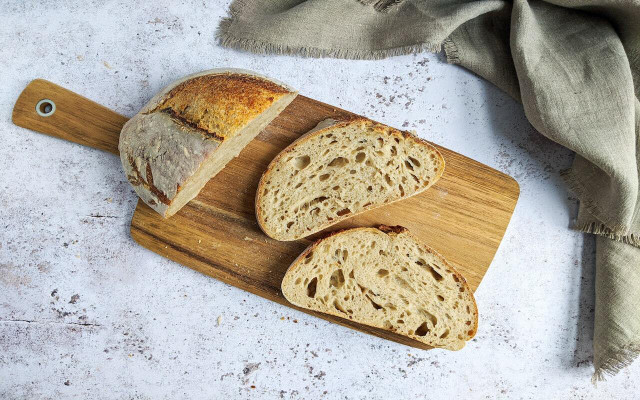How do you get the most from your loaf if you don’t eat it in one go? Here are our top tips on how to store sourdough bread to help keep it fresh.
Fresh bread is one of the most delicious creations, and sourdough bread is no exception. Like most fresh bread, sourdough is at its best when eaten within 24 hours as it has the tendency to go stale if not well looked after. We’ll look at practical tips on how to store sourdough bread so that it stays fresh for longer. Done correctly, you can enjoy sourdough bread’s crispy outer layer and inner softness for longer, without having to throw it away.
Before we get on to storing your sourdough bread, it’s worth noting how not to store it: don’t store it in the fridge. The cold temperature is too harsh for bread, and it will get stale much faster than if left at room temperature. Not to worry though, it’s easy to store sourdough bread, due to its natural acidity, and our methods show you how to keep it fresher, for 5 days and beyond.
What Is Sourdough Bread?

(Foto: CC0 / Pixabay / tombock1)
Sourdough bread differs from standard bread because it uses a special starter mixture of wild yeast and bacteria. Sourdough bread is healthy and has many benefits, making it a great addition to your diet. Sourdough bread has the following benefits:
- Easy to digest: the yeast and bacteria mix breaks down the starches in the grains, making it easy on the digestive system.
- May be a good option for those with mild gluten issues: Protein gluten is broken down into amino acids before it reaches your stomach. However, sourdough bread isn’t gluten-free.
- Has a lower glycemic index: Compared to other types of bread, the fermentation process involved in making sourdough bread also depletes starches, keeping blood sugars more balanced.
- Contains good acid: The bacteria used (Lactobacillusis) contains a higher level of lactic acid than many other types of bread. Lactic acid assists digestion and contains beneficial minerals. This also means phytic acid (which can be potentially dangerous) is minimized.
- Contains healthy bacteria, and less yeast.
- Contains natural ingredients, and has been enjoyed for centuries.
- Contains fewer preservatives. Sourdough bread naturally preserves itself, due to acetic acid preventing the growth of mold.
- Nutritious. Sourdough bread contains iron, calcium, B Vitamins, folate, zinc, potassium selenium, and iron, to mention just a few nutritional benefits, and maintains many original nutrients which may have been processed out of other kinds of bread.
Sourdough bread is also delicious! We have a great recipe for sourdough bread and plenty of ideas for how to use it if it goes stale. Though once you learn how to store sourdough bread properly, you probably won’t have much stale bread left over.
How to Store Sourdough Bread for Up to 5 Days



(Foto: CC0 / Pixabay / cromaconceptovisual)
The first thing to consider is what you will store the bread in. The best option is in a linen bag, though a paper bag will also work. You can also store sourdough bread in a closed breadbox. Alternatively, wrap in a dry teatowel.
Day 1-2
If the loaf has been cut, store the cut side down. Wrapping your bread will keep it fresh for up to 2 days, minimizing loss of moisture, while protecting the inside of the loaf from drying out.
Day 3-5
Now it is best to transfer your sourdough bread to a large reusable silicone bag. You may find the crust softens but is easy to crisp up again by placing it in a warm oven for a brief time, or by toasting.
Alternatively, you can use a DIY beeswax wrap. They are porous so the bread won’t dry out as much, but should also maintain its crispy crust.
Day 5 and Onwards



(Foto: CCO Public Domain / Unsplash / Debbie Widjaja)
Once you know you won’t be eating your loaf, you should consider freezing it. Sourdough bread freezes well and can be kept for up to 6 months in the freezer. Bear in mind that the longer you leave it, the more the flavor will begin to diminish. You can freeze your sourdough loaf whole, or slice it. Slicing is a better option if you just wish for a few slices at a time.
To freeze whole sourdough loaves:
- Place the loaf in a sealable and reusable freezer bag.
- Remove as much air as possible from the bag, and close or seal it.
- Freeze.
To freeze sliced sourdough bread:
- Cut into slices
- Place a sheet of baking paper between the slices (for easier separation).
- Follow the same instructions as above.
After defrosting, liven up the bread by spritzing it with a little water, then warming it in the oven (or the slices in the toaster).
Using Up Leftover Sourdough Bread



(Foto: CC0 / Pixabay / tookapic)
And there we have it, stunning sourdough bread, for longer. If you have some left that you want to use up or are looking for different ways to use both fresh and stale bread, find inspiration in our recipes below.
The tricks for storing sourdough bread also apply when figuring out how to store homemade bread in general. You can also use any of the following recipes to use up leftover sourdough or other homemade bread:
- Whip up some eggless french toast
- Crisp up some croutons to pair with a delicious homemade soup,
- Use our stale bread recipes to make some dumplings or a bread casserole
Read more:
- Is Bread Vegan? Brands, Recipes and Tips
- Gluten-Free, Yeast-Free Bread: A Life-Changing Recipe
- Best Way to Store Coffee Beans
Do you like this post?






